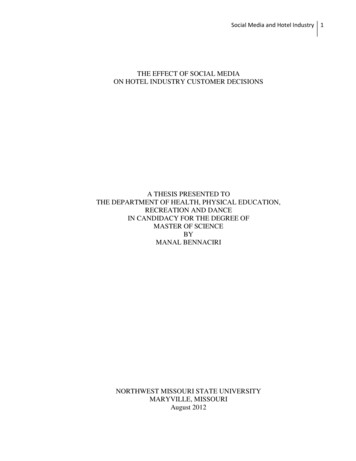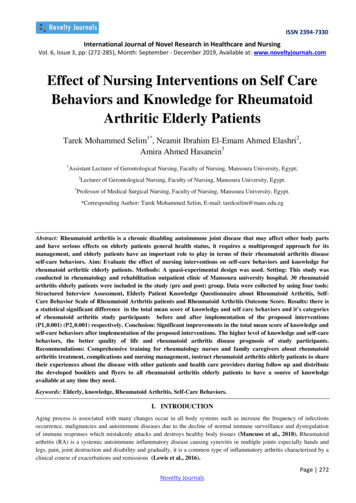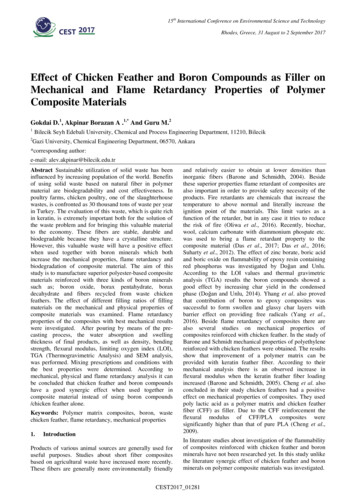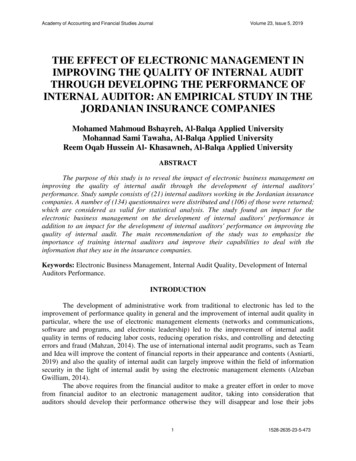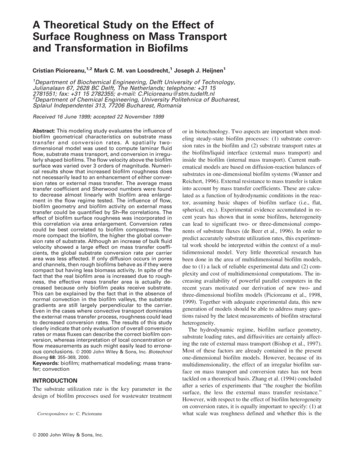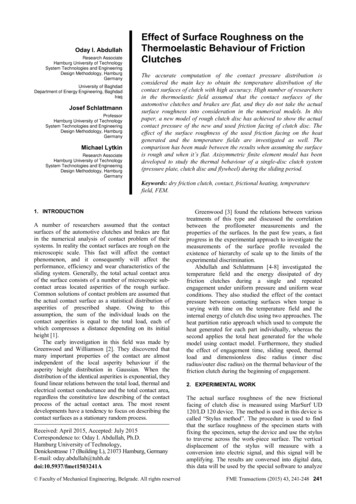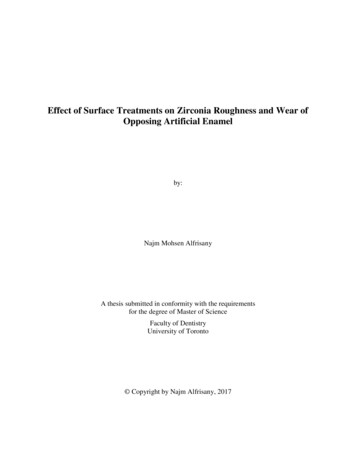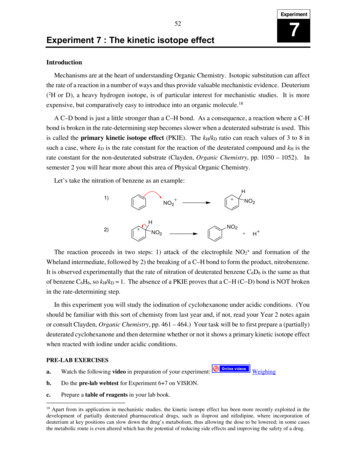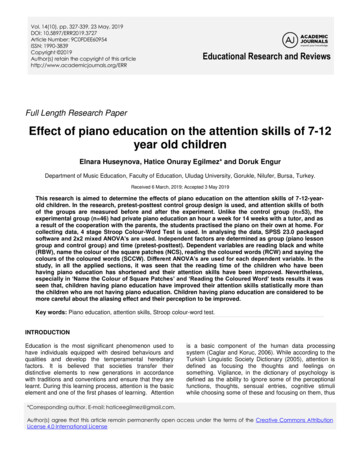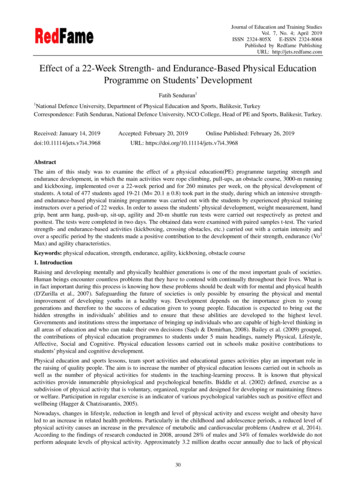
Transcription
Journal of Education and Training StudiesVol. 7, No. 4; April 2019ISSN 2324-805X E-ISSN 2324-8068Published by Redfame PublishingURL: http://jets.redfame.comEffect of a 22-Week Strength- and Endurance-Based Physical EducationProgramme on Students’ DevelopmentFatih Senduran11National Defence University, Department of Physical Education and Sports, Balikesir, TurkeyCorrespondence: Fatih Senduran, National Defence University, NCO College, Head of PE and Sports, Balikesir, Turkey.Received: January 14, 2019doi:10.11114/jets.v7i4.3968Accepted: February 20, 2019Online Published: February 26, 2019URL: https://doi.org/10.11114/jets.v7i4.3968AbstractThe aim of this study was to examine the effect of a physical education(PE) programme targeting strength andendurance development, in which the main activities were rope climbing, pull-ups, an obstacle course, 3000-m runningand kickboxing, implemented over a 22-week period and for 260 minutes per week, on the physical development ofstudents. A total of 477 students aged 19-21 (M 20.1 0.8) took part in the study, during which an intensive strengthand endurance-based physical training programme was carried out with the students by experienced physical traininginstructors over a period of 22 weeks. In order to assess the students’ physical development, weight measurement, handgrip, bent arm hang, push-up, sit-up, agility and 20-m shuttle run tests were carried out respectively as pretest andposttest. The tests were completed in two days. The obtained data were examined with paired samples t-test. The variedstrength- and endurance-based activities (kickboxing, crossing obstacles, etc.) carried out with a certain intensity andover a specific period by the students made a positive contribution to the development of their strength, endurance (Vo 2Max) and agility characteristics.Keywords: physical education, strength, endurance, agility, kickboxing, obstacle course1. IntroductionRaising and developing mentally and physically healthier generations is one of the most important goals of societies.Human beings encounter countless problems that they have to contend with continually throughout their lives. What isin fact important during this process is knowing how these problems should be dealt with for mental and physical health(D'Zurilla et al., 2007). Safeguarding the future of societies is only possible by ensuring the physical and mentalimprovement of developing youths in a healthy way. Development depends on the importance given to younggenerations and therefore to the success of education given to young people. Education is expected to bring out thehidden strengths in individuals’ abilities and to ensure that these abilities are developed to the highest level.Governments and institutions stress the importance of bringing up individuals who are capable of high-level thinking inall areas of education and who can make their own decisions (Saçlı & Demirhan, 2008). Bailey et al. (2009) grouped,the contributions of physical education programmes to students under 5 main headings, namely Physical, Lifestyle,Affective, Social and Cognitive. Physical education lessons carried out in schools make positive contributions tostudents’ physical and cognitive development.Physical education and sports lessons, team sport activities and educational games activities play an important role inthe raising of quality people. The aim is to increase the number of physical education lessons carried out in schools aswell as the number of physical activities for students in the teaching-learning process. It is known that physicalactivities provide innumerable physiological and psychological benefits. Biddle et al. (2002) defined, exercise as asubdivision of physical activity that is voluntary, organized, regular and designed for developing or maintaining fitnessor welfare. Participation in regular exercise is an indicator of various psychological variables such as positive effect andwellbeing (Hagger & Chatzisarantis, 2005).Nowadays, changes in lifestyle, reduction in length and level of physical activity and excess weight and obesity haveled to an increase in related health problems. Particularly in the childhood and adolescence periods, a reduced level ofphysical activity causes an increase in the prevalence of metabolic and cardiovascular problems (Andrew et al, 2014).According to the findings of research conducted in 2008, around 28% of males and 34% of females worldwide do notperform adequate levels of physical activity. Approximately 3.2 million deaths occur annually due to lack of physical30
Journal of Education and Training StudiesVol. 7, No. 4; April 2019activity (WHF, 2017). Physical inactivity is seen as the reason for one in every ten deaths (King, 2012). Moreover, thenumber of people with obesity has seen a large increase over the last 20 years, with the majority in European countries(OECD, 2010).It is known that regular physical activity can prevent a large number of chronic medical problems, including many typesof cardiovascular disease, in all age groups. Researchers have revealed that performing at least 150 minutes’ balancedphysical exercise or at least one hour’s dynamic physical activity per week can reduce the risk of coronary heart diseaseby about 30% (WHO, 2017). In order to obtain these benefits (positive health effects) at least 60 minutes of regularphysical activity are required per day (WHO, 2017). Regular physical activity in young people reduces the risk ofchildhood and adolescent obesity and decreases the risk of costly and fatal chronic diseases related to obesity (Erfle &Gamble, 2015).Parents, educators, doctors and trainers accept the health benefits of and encourage regular physical activity in shapingyoung people’s lives (Patel & Greydanus, 2010). Since a large number of children and youths can be reached, the schoolenvironment is regarded as an ideal platform for promoting physical activity and regular exercise. By means of physicaleducation lessons in schools, students are given the opportunity to perform physical activities during lessons (Verrotti etal., 2014).However, due to reasons such as a focus on academic success with an intensive curriculum or inadequacy of sportsfacilities in schools, students may not always be provided with the desired levels of physical activity and exercise(Andrew et al, 2014). It is recommended that 225 minutes of physical education lessons/activities per week are plannedfor students during their education in middle and high school (NASPE, 2004; CDCP, 2011). The studies conductedshow that individual physical activities performed during the student period (adolescence) have a direct effect on habitsof participation in regular physical activity when the students become adults (Godin & Shephard, 1990; Gallotta et al.,2017).Physical education curricula can be shaped according to the characteristics of the careers that students educated inschools are to follow after they graduate. Students in military schools and police training schools can be given moreintensive, strength- and endurance-based training aimed at acquiring professional skills.2. MethodIn this study, the effect of a 22-week physical education programme, in which exercises such as rope climbing, pull-ups,an obstacle course, 3000-m running and kickboxing were the main activities, on the development of students’ strengthand endurance characteristics compared to their starting levels, was examined.2.1 SubjectsThis study was carried out with a total of 477 healthy students aged 19-21 (mean 20.1 0.8) attending vocational highschool. All participants signed an informed consent form prior to participation in the study according to the Declarationof Helsinki and were assessed with the Borg Scale after all the exercises.2.2 Research ProtocolIn the study, an intensive strength- and endurance-based physical training programme was applied to the students byexperienced physical training instructors over a 22-week period. The physical education lessons were carried out over80 minutes on one day per week. For the first 10 minutes of each lesson, a warm-up was conducted, followed by a60-minute main period and finally a 10-minute cool-down. In addition, kickboxing training was given on one day aweek for 60 minutes.2.3 Research DesignThe research was carried out over 22 weeks (Table 1). The participants performed strenuous exercises for at least 48hours prior to the physical tests. Before each test period began, participants were asked to do warm-ups according totheir own routines. The tests were completed in two days. The 20-m shuttle run tests were performed on the second day.In order to assess the students’ physical development, weight measurement, hand grip, bent arm hang, push-up, sit-up,agility and 20-m shuttle run tests were carried out respectively at the beginning of the 22-week physical trainingprogramme as pretest and at the end of the 22-week physical training programme as posttest (Table 2).31
Journal of Education and Training StudiesVol. 7, No. 4; April 2019Table I. Content and Duration of Physical Education Programme Applied over 22 WeeksIntensitySubjectKickboxingObstacle CourseRope Climbing3000-m RunningStrength DevelopmentCoursePull-ups, Push-ups,Sit-upsContentJab, front kick, side kick, turns,jumps.20 obstacles, 400-m track lengthGrip, squeeze, pull, ascent,descentIntermittent, maximal,incremental running.Log exercises, tyre-pulling,paired exercises, etc.Circuit trainingOne Daya WeekDurationTotal60 minutes22 weeks1320 minutes50 minutes6 weeks300 minutes50 minutes5 weeks250 minutes50 minutes6 weeks300 minutes50 minutes5 weeks250 minutes10 minutes22 weeks220 minutesTable II. Physical Test Methods AppliedMethodMeasuredHand GripStatic Arm StrengthBent Arm HangFunctional Strength (Arm and Shoulder Muscle Resistance)Push-upUpper Body StrengthSit-upBody Strength (Abdominal Muscle Resistance)20-m Shuttle RunCardiorespiratory FitnessIllinois Agility TestRunning Speed and Agility2.4 Statistical AnalysisData were analyzed by using the IBM SPSS Statistics version 20 software for Windows (IBM Corp., 2011, Armonk, NY,USA). Descriptive statistics were presented as mean and standard deviation. A Kolmogorov-Smirnov normality wasperformed to test for normality and paired-samples t tests were applied to determine the variables between pre-test andpost-test. The statistical significance level was set at p 0.05 and p 0.01.3. ResultsFollowing the research, the percentage differences and statistical significance levels in the results obtained from thestudents at the beginning of the training period and at the end of the 22-week programme are presented in Table 3.According to the pretest and posttest mean scores, there was a 1.12% change in the students’ pretest (M 68.42,SD 6.85) and posttest (M 69.19, SD 6.93) weights (kg) (p .001). According to the push-up repetitions, there was a46.6% change in the students’ pretest (M 29.12, SD 9.11) and posttest (M 42.69, SD 8.22) push-up repetition scores(p .001). As for sit-up repetitions, the students’ pretest (M 38.36, SD .26) and posttest (X 41.92, SD .244) sit-uprepetition scores changed at a rate of 9.28% (p .001). The findings for the students’ bent arm hang periods revealed anincrease in hang duration of 10.06% from (M 35.38, SD 13.27) in pretest to (M 41.49, SD 14.97) in posttest(p .001). According to hand grip measurements, there was a 6.92% change in the students’ pretest (M 46.78, SD 7.12)and posttest (M 50.02, SD 6.58) grip strength scores (p .001). In the agility test, there was a 14.08% change in thestudents’ pretest (M 19.10, SD 1.25) and posttest (M 16.41, S D 1.08) finishing times (p .001). In the 20-m shuttlerun, the students’ pretest (M 64.29, SD 13.68) and posttest (M 67.61, S D 13.11) periods changed at a rate of 5.16%(p .001).Table III. Pretest and Posttest Mean values ( SD) of measured parameters of participantsPre-testMeasured VariableWeight (kg)Push-up(rep)Sit-up(rep)Bent Arm Hang(sec)Hand GripAgility(sec)20-m Shuttle 50.0216.4167.61*p 0.05, ***p .2810.066.92- 2.99***48.86***-4.98***df476
Journal of Education and Training StudiesVol. 7, No. 4; April 20194. DiscussionVarying the content of physical education lessons in line with the training objectives contributes to increasing students’interest in the lessons and to a more dynamic lesson process. In this study, with the aim of developing students’ physicalcharacteristics and varying the lessons, kickboxing and obstacle crossing were included in the teaching programme.Kickboxing is a combat sport, generally done on foot for self-defence, and is based on kicks and punches. Because of itsbenefits for self-protection, increasing muscle strength and keeping the body in shape, it has attracted continuouslyincreasing interest worldwide (Kaynar et al, 2016). Performing kickboxing regularly activates the major muscle groups,while it promises development of balance, coordination and self-esteem in an enjoyable fashion (Kaynar et al, 2016).Kickboxing training includes many elements such as strength, balance and endurance training.The strength- and endurance-based physical training programme regularly implemented over a period of 22 weeksresulted in significant contributions to the development of the students’ strength and endurance characteristics. Thestudents’ scores increased in hand grip, bent arm hang, push-ups, sit-ups, agility and 20-m shuttle run. Especially inpush-ups and pull-ups with bent arm, both of which require arm strength, the rate of increase in their scores was higherthan in the other parameters. It can be said that the bent arm hang movement carried out in the lessons and the push-upmovement applied at the end of each lesson contributed positively to the development of the relev
50 minutes 5 weeks 250 minutes Pull-ups, Push-ups, Sit-ups Circuit training 10 minutes 22 weeks 220 minutes Table II. Physical Test Methods Applied Method Measured Hand Grip Static Arm Strength Bent Arm Hang Functional Strength (Arm and Shoulder Muscle Resistance) Push-up Upper Body Strength Sit-up Body Strength (Abdominal Muscle Resistance) 20-m Shuttle Run Cardiorespiratory Fitness Illinois .

